View this article in another language
- 한국어
- English
- 日本語
- 中文
- العربية
- Español
- Français
- Deutsch
- Pусский
- Tiếng Việt
- Indonesian
If you’re travelling in Korea, you’ve gotta get yourself to a traditional market! Filled with every snack and knick-knack you can imagine, the traditional markets are a real slice of Korean culture. They hum with the sounds of haggling customers and flickering lights and the scent of fresh and fermented vegetables permeates the tented streets. There’s so much to see: barrels overflowing with dried peppers and tables stacked high with roots and tubs of dried fish, people racing up and down the narrow alleys on scooters and vendors carrying trays of food on their heads. Browsing the markets is always a treat and of all the markets I’ve visited, Daegu’s Bangcheon Market is one of my favorites.
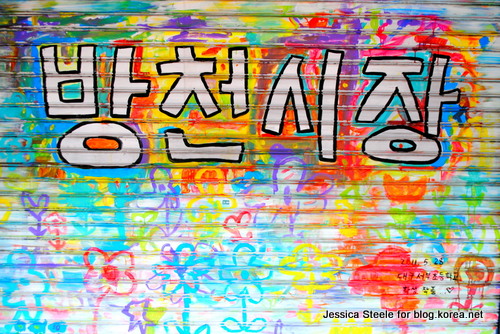
Daegu is known for its many thriving specialty markets. There’s a market for practically every niche – medicine, dried fish, dried goods, and more! While Bangcheon Market sells a little bit of everything, what really makes it stand out is its unique look. In the late 2000s the local government turned its eye to some of the city’s failing traditional markets and decided to give them a boost in an effort to preserve the local culture and history. Bangcheon Market (방천시장) was suffering due to a lack of visitors and was close to shutting down permanently in 2010. The city stepped in with a creative revitalization project to bring the tourists back. That year, the Kim Kwang-Seok Memorial Street was opened and by 2012, the rest of Bangcheon Market was given a colorful makeover by a team of young artists, painting the once-forlorn alleyways with the bright murals for which they are now famed.
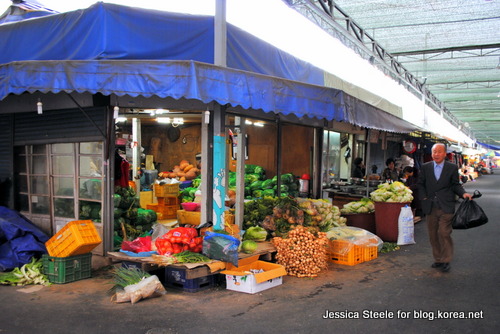
Bangcheon Market was established following the end of the Japanese occupation of Korea in 1945. Refugees returned home and started new lives for themselves, some setting up shop in the newly formed market alongside what is now called Sincheon Bridge. They took the market’s name from the word Bangcheon, meaning ‘a fence to keep high waters out’. The newly-returned citizens had long suffered under the occupation and chose this name for their market in hopes of blocking any further misfortune from coming their way. Today the market is home to 80 vendors and – aside from several cosmetic changes – the market has remained relatively unchanged since its establishment nearly 70 years ago.
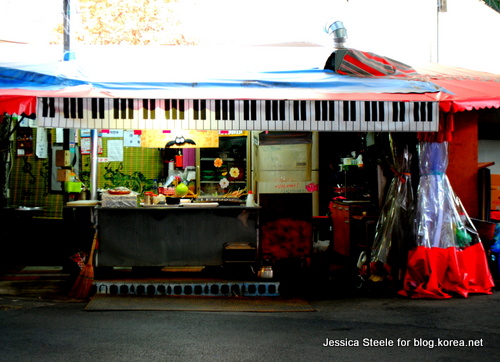
Inside the market, you’ll find colorful paintings and whimsical decorations, a fitting complement to the bright hues of the tents and the goods sold in them. You can pick up snacks at a deliciously cheap price, enjoy tteokbokki, odeng, and hotteok until you’re about to burst, or slip into one of the quaint tiny cafés. On summery Saturday nights, the tiny alleyways buzz with artists and musicians who populate the thriving night market. If snacks, art, music, and coffee aren’t your thing (gasp!), you can also visit the market for more standard fare like veggies, fruit, herbs, meat, and rice. Household products like clothes, slippers, and kitchen gadgets can be found there, too, piled dangerously high in buckets and teetering on tabletops.
At the outer perimeter of the market you’ll find the 350-metre-long Kim Kwang-Seok Memorial Street. This colorfully-painted alleyway marks the birthplace of the much-loved Korean folk rock singer who tragically took his life in 1996. Born in Daegu in 1964, Kim Kwang-Seok (김광석) lived in one of the street’s many small houses until his family moved to Seoul when he was five. Now the street serves as the outer perimeter of the market, though a few of the original homes can still be seen at the end of the road, giving a glimpse into that era.
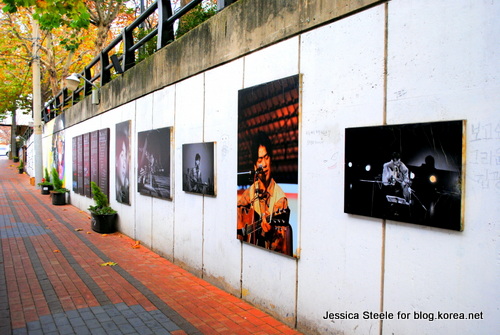
During his school years, Kim was known as a bright student and talented musician. The son of a former teacher, Kim learned about social activism when his father was dismissed from his position due to involvement with a teacher’s union, which was banned by the government at that time. In college, Kim was so moved by the works of activist-musicians like Kim Min-Ki (김민기) that in 1984 he joined a singer-songwriter student activist group to help create politically-motivated anthems of his own. Until the early 1980s, student bands and groups were performing some of Korea’s most radical music during this tumultuous political era. This was in part due to their somewhat privileged status as university students and the experimental freedoms that this station provided them. Students like Kim continued to create politically-charged music until the early 1990s.
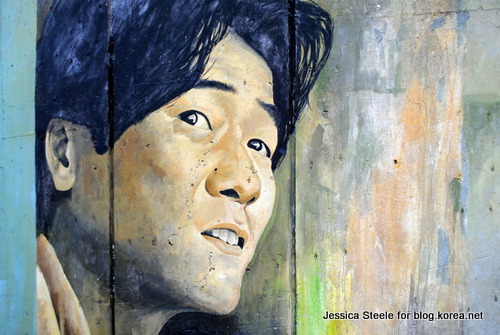
After completing his two years of mandatory military service, Kim returned to school in 1987 and joined another student singers’ activist group. His first performance was so well-received that he was invited to perform at political rallies to represent the group. During this time, he also formed the band Dongmulwon (동물원, The Zoo). Under the guidance of singer Kim Chang Wan (김창완) from the popular rock group Sanwoolim (산울림, Mountain Echo), Dongmulwon skyrocketed to success with their first album. Propelled forward by this, Kim Kwang-Seok released his first solo album in 1989 and by the end of his career he had released six studio albums, five compilations, and his music had appeared in soundtracks for three major films. By 1995, Kim had been performing for over a decade and had played 1000 concerts, many of them at small, intimate venues. He was lauded as the most successful Korean musician before his untimely death in 1996, and (in some circles) controversy still clouds the tragic event to this day. Today, nearly 20 years later, his albums continue to sell with his music appearing in TV shows and movies and memorials in his name can be found across the country.
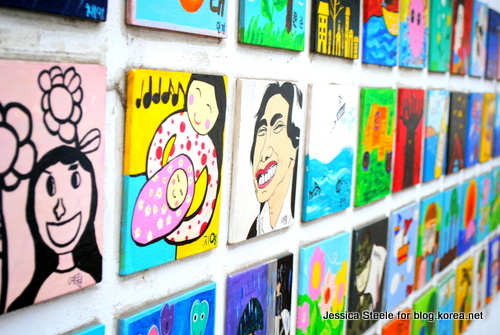
The Kim Kwang-Seok Memorial Street in Daegu was created by a team of 20 mural and sculpture artists and designers. At just 2.5 metres wide, the street is peppered with fan art, lyrics from popular songs, portraits, and colorful sculptures. Approximately 70 paintings line the alley. Many depict Kim performing in the small concert halls that he loved so much, while one shows the singer running a food tent reminiscent of the market nearby. On any given day you’ll find people wandering the street and taking photos or leaving tokens of thanks, like singer and fan Che Hwan. Che has visited the street every week since 2012 to give street performances of Kim’s music and even erected a bronze statue of Kim with his earnings. The singer appeared on JTBC’s show Hidden Talent in December 2013 and has been dubbed “The Second Kim Kwang-Seok”. Che now makes a living bringing his hero’s music back to life and he is adamant that he will donate part of his earnings to helping maintain the street and the memory of his hero, just as local vendors are working hard to preserve the memories of Bangcheon Market.
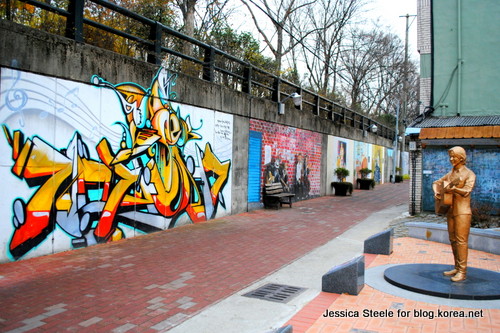
If you want to find Bangcheon Market, hop on Green Line #2 on the Daegu Subway and leave by Exit 3. Walk 5 – 10 minutes until you see one of the two large arched gates on your right. These indicate the entrances to the market. Kim Kwang-Seok Memorial Street can be found past the second gate.
Written by Jessica Steele for The Korea Blog. Content may not be reproduced without permission.

Colorful paintings line the streets at Daegu’s Bangcheon Market
Daegu is known for its many thriving specialty markets. There’s a market for practically every niche – medicine, dried fish, dried goods, and more! While Bangcheon Market sells a little bit of everything, what really makes it stand out is its unique look. In the late 2000s the local government turned its eye to some of the city’s failing traditional markets and decided to give them a boost in an effort to preserve the local culture and history. Bangcheon Market (방천시장) was suffering due to a lack of visitors and was close to shutting down permanently in 2010. The city stepped in with a creative revitalization project to bring the tourists back. That year, the Kim Kwang-Seok Memorial Street was opened and by 2012, the rest of Bangcheon Market was given a colorful makeover by a team of young artists, painting the once-forlorn alleyways with the bright murals for which they are now famed.

A happy customer passes one of Bangcheon Market’s overflowing stalls
Bangcheon Market was established following the end of the Japanese occupation of Korea in 1945. Refugees returned home and started new lives for themselves, some setting up shop in the newly formed market alongside what is now called Sincheon Bridge. They took the market’s name from the word Bangcheon, meaning ‘a fence to keep high waters out’. The newly-returned citizens had long suffered under the occupation and chose this name for their market in hopes of blocking any further misfortune from coming their way. Today the market is home to 80 vendors and – aside from several cosmetic changes – the market has remained relatively unchanged since its establishment nearly 70 years ago.

A tent decorated to look like a keyboard, one of the market’s many whimsical sights
Inside the market, you’ll find colorful paintings and whimsical decorations, a fitting complement to the bright hues of the tents and the goods sold in them. You can pick up snacks at a deliciously cheap price, enjoy tteokbokki, odeng, and hotteok until you’re about to burst, or slip into one of the quaint tiny cafés. On summery Saturday nights, the tiny alleyways buzz with artists and musicians who populate the thriving night market. If snacks, art, music, and coffee aren’t your thing (gasp!), you can also visit the market for more standard fare like veggies, fruit, herbs, meat, and rice. Household products like clothes, slippers, and kitchen gadgets can be found there, too, piled dangerously high in buckets and teetering on tabletops.
At the outer perimeter of the market you’ll find the 350-metre-long Kim Kwang-Seok Memorial Street. This colorfully-painted alleyway marks the birthplace of the much-loved Korean folk rock singer who tragically took his life in 1996. Born in Daegu in 1964, Kim Kwang-Seok (김광석) lived in one of the street’s many small houses until his family moved to Seoul when he was five. Now the street serves as the outer perimeter of the market, though a few of the original homes can still be seen at the end of the road, giving a glimpse into that era.

70 paintings line Kim Kwang-Seok Memorial Street
During his school years, Kim was known as a bright student and talented musician. The son of a former teacher, Kim learned about social activism when his father was dismissed from his position due to involvement with a teacher’s union, which was banned by the government at that time. In college, Kim was so moved by the works of activist-musicians like Kim Min-Ki (김민기) that in 1984 he joined a singer-songwriter student activist group to help create politically-motivated anthems of his own. Until the early 1980s, student bands and groups were performing some of Korea’s most radical music during this tumultuous political era. This was in part due to their somewhat privileged status as university students and the experimental freedoms that this station provided them. Students like Kim continued to create politically-charged music until the early 1990s.

Portrait of the late singer Kim Kwang-Seok at his memorial street in Daegu
After completing his two years of mandatory military service, Kim returned to school in 1987 and joined another student singers’ activist group. His first performance was so well-received that he was invited to perform at political rallies to represent the group. During this time, he also formed the band Dongmulwon (동물원, The Zoo). Under the guidance of singer Kim Chang Wan (김창완) from the popular rock group Sanwoolim (산울림, Mountain Echo), Dongmulwon skyrocketed to success with their first album. Propelled forward by this, Kim Kwang-Seok released his first solo album in 1989 and by the end of his career he had released six studio albums, five compilations, and his music had appeared in soundtracks for three major films. By 1995, Kim had been performing for over a decade and had played 1000 concerts, many of them at small, intimate venues. He was lauded as the most successful Korean musician before his untimely death in 1996, and (in some circles) controversy still clouds the tragic event to this day. Today, nearly 20 years later, his albums continue to sell with his music appearing in TV shows and movies and memorials in his name can be found across the country.

Local artists and market vendors collaborated to create the memorial street
The Kim Kwang-Seok Memorial Street in Daegu was created by a team of 20 mural and sculpture artists and designers. At just 2.5 metres wide, the street is peppered with fan art, lyrics from popular songs, portraits, and colorful sculptures. Approximately 70 paintings line the alley. Many depict Kim performing in the small concert halls that he loved so much, while one shows the singer running a food tent reminiscent of the market nearby. On any given day you’ll find people wandering the street and taking photos or leaving tokens of thanks, like singer and fan Che Hwan. Che has visited the street every week since 2012 to give street performances of Kim’s music and even erected a bronze statue of Kim with his earnings. The singer appeared on JTBC’s show Hidden Talent in December 2013 and has been dubbed “The Second Kim Kwang-Seok”. Che now makes a living bringing his hero’s music back to life and he is adamant that he will donate part of his earnings to helping maintain the street and the memory of his hero, just as local vendors are working hard to preserve the memories of Bangcheon Market.

Singer Che Hwan commissioned this statue to commemorate his idol.
If you want to find Bangcheon Market, hop on Green Line #2 on the Daegu Subway and leave by Exit 3. Walk 5 – 10 minutes until you see one of the two large arched gates on your right. These indicate the entrances to the market. Kim Kwang-Seok Memorial Street can be found past the second gate.
Written by Jessica Steele for The Korea Blog. Content may not be reproduced without permission.